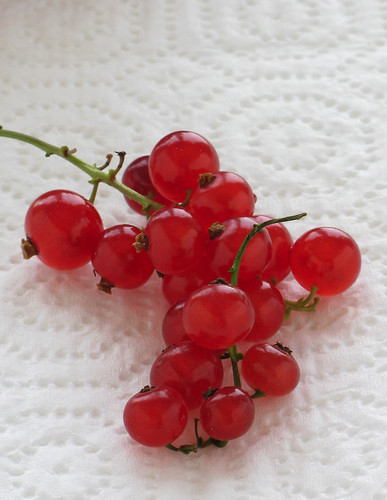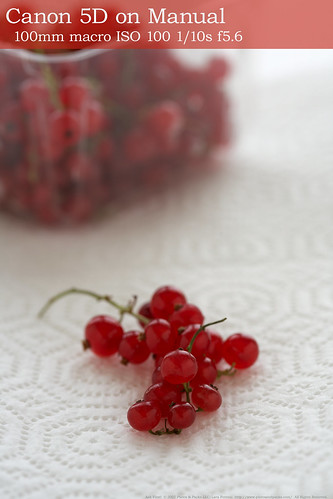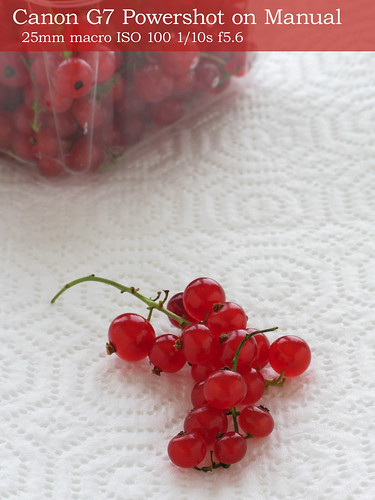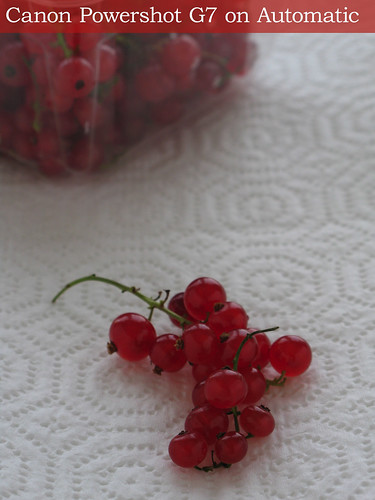The dSLR Lovers Point & Shoot

If you’ve been using a digital SLR for a while, you know how frustrating it can be to pick up a point and shoot camera and get good shots. For that matter, if you use a point and shoot, you might be just as frustrated. A point and shoot, for all its ease of size and automation, makes all kinds of decisions for you in what makes a good photo, and while often it is right, it is just a piece of hardware and can’t read your mind about exactly what you want. When you photograph food, this becomes particularly clear.
The settings in most point and shoots are geared toward what most people take photos of most of the time. People. And, to be specific, people in decent, bright lighting conditions. All of those automatic settings on your camera do what they can to make the best choices to get great shots of people in the park or at the zoo or at graduation. They get all confused when you make them take a photo of a plate of food in a dimly lit restaurant. The beauty of the digital SLR is that you can tell the camera exactly what you want… that the front edge of your panna cotta should be in focus, not some random point in the middle; that the napkin sitting next to the plate is white even though the candle light is making it look pretty yellow; that you want all the background noise to fade away into a nice blur. Most point and shoot cameras give you a little feature here and there… a macro button to let you focus on a subject within a few inches or maybe a setting for daylight versus candle light or shade… but still keep most of the decisions away from you. And, because of that, I usually just give up, and decide to forgo taking any photos while dining out.
Enter the Canon Powershot G7, or the foodie photographers new best friend. This camera does everything your standard point and shoot does and does it well. With 10 megapixels, it’s even more powerful than my old dSLR, the Canon 20D (yes, I said old… I upgraded to the Canon 5D a few weeks ago, and am loving it!) while still fitting easily within a purse or a jacket pocket. While it’s not as small as many digital point and shoots– it’s much bigger than my phone, for example– it also lets you do things that few other P&S cameras let you do… switch into complete manual mode. And I mean complete. You can manually adjust focus, aperture and shutter speed, so you get to make decisions when the camera isn’t automatically doing the right thing. And, with built in image stabilization, ISO of up to 1600 you can get some pretty incredible shots in dimly lit rooms. I still will always recommend a tripod for dark room shots, but this camera will work really well with one of the super small tripods, like the Joby Gorillapod.
Here’s a quick test I did comparing the automatic mode of the G7 to the manual mode as well as shooting with my Canon 5D dSLR. Now, this isn’t a particularly scientific test… the focal length of the shots is different so that throws a bit of a wrench in the whole thing. I could have made the focal length of the G7 match, but as I said, this was a quick test. Still I think you can get a pretty good idea of how close you can get to a digital SLR with this camera once you start to learn how to use it.
Each of these photos was taken in the same lighting conditions, as well as using a tripod. I should have been using a remote for the G7, but just tried to be as steady as I could with the shutter, to a pretty good result. I shot with the 5D first, and then used the same camera settings on the G7 for manual mode.



You’ll notice first of all that the automatic shot, doesn’t look very good. It’s too dark because the camera didn’t know what tone should be the mid-tone… so it decided that the white should be… hence the dingy grey. The point of focus is also just a tiny bit off… it’s behind the first couple of currants. The automatic mode actually gave a shallower depth of field as well… the aperture was f4.0, exposure time was 1/50s. On the 5D photo, I got an even narrower DOF – this is a byproduct of the focal length not the aperture – so just try to ignore that. All in all, the quality of the G7 image, especially for blogging or other web-use is pretty darn good.
If you are looking for a new camera, and are torn between a point and shoot & stepping up to a digital SLR, this just might be the right step.
Technorati Tags: camera gear, Photography, Tech

When my old P&S died, I decided to go with the G7…I’ve now had it for a few months and am really pleased with the results that it is giving me. I would still love to be able to invest in something like the Canon 30D, but as that’s out of my price range at the moment, the G7 will suffice till I can afford to upgrade 🙂
(Apologies for having a non-food related comment.) I’m really loving the G7. My photos don’t compare to L’s, but you can check out a couple of the interior church shots that I took on our recent trip to London. In King’s College you aren’t allowed to use flash, which can really hurt the typical P&S. Between setting the ISO to 800 and Manual mode, I was able to get some pictures that I never would have got with our old Lumix:
Stained glass window inside the church
Inside the church #2
That manual shot look pretty good! I have a now fairly old Canon Powershot (the G3) and have been really pleased with it (aside from the point and shoot limitations that you mention). Now sure what this new model is like but mine is particularly comfy to use – good for small hands but not so light that it’s impossible to keep still. I was thinking about upgrading to a dSLR at some point but I’ll have to check this one out as well!
I’m disappointed that the G7 doesn’t offer a RAW mode. One of the things that’s consistently a problem with any digital camera is that the auto white balance is crappy, which is especially problematic for food photography. Without a RAW file, your latitude for adjusting white balance is seriously limited.
You can get a used original Canon Digital Rebel with a 50mm f/1.8 for the same price as a new G7 and get much better pictures from a camera that’s not even that much bigger. The images out of my dRebel were not noticeably different from those out a 20D or 30D.
Patrick – you raise a good point about Raw… For some reason Canon actually removed Raw support from the G7 (it was in the G6), which I think was a bad idea. You are right, you get a lot more flexibility of correcting color and exposure when you can shoot in Raw.
That said, you can set the white balance on the G7 in camera to avoid the color cast problems in camera, instead of fixing them all in post process. This is generally a good idea regardless, as it’s a two second setup problem, versus a change to every photo you shoot… so not having a Raw mode isn’t a showstopper.
The Rebel is a good choice, but then, you have to carry around a lot bigger gear, and you’ll still end up with smaller file sizes (depending on how old of a Rebel model you get), and are limited by the 50mm lens. The G7 has a pretty amazing optical zoom on it for being such a little guy.
nice sharing, thank you so much.
yes… there will be days when i have enough with SLR and get tired of carrying it around.
The G7 is definitely a sexy camera, but in the end I had to pick the Ricoh GX100 over it for the RAW mode. Canon, especially, seems to like warming up pictures a bit too much for my liking, and if I were to be using a PnS, the last thing I’d want is to be fiddling around with the WB. The GX100 also offers full manual mode (including focus, aperture, shutter and ISO), as well as their image-stabilization mechanism. So for those of you who really, really like the G7 but can’t bring yourself to spend that much on a camera without RAW, there’s another option for you that doesn’t quite spell dSLR yet. 🙂
As someone who is tired of lugging a big camera around I’m thissssssssssss close to picking up a good PnS so that I can travel with ease. However, I’m going to have to do some serious soul searching about the lack of RAW in this camera – not that a super high quality JPG file wouldn’t work in a pinch.
But it’s SUCH a beautiful little camera! Fantastic images!
w. – Great tip on the Ricoh. We didn’t look at that one when we got the G7, but I know there are others out there that support manual mode, and I think that’s the key. We had picked up the Panasonic Lumix just about 6 monhths before… talked into it because it was the same as the small digital Leica, just with different branding… and we ended up getting too annoyed with it. Since we had a Canon Elph before, that’s just where we started looking, and certainly have’t been disappointed, at least not for our uses.
Matt – I do hear you on Raw support. I really don’t get it why Canon pulled it. I don’t think it ends up making a huge difference in image quality for the things we are using this camera for, but I do with I could use Capture One with the files for my more standard workflow. It is making me a touch closer to getting Lightroom or Aperture for those quick exposure and color adjustment fixes so I don’t have to bother opening up every file in Photoshop. Maybe you should check out the Ricoh that W. suggested…
-L
http://www.pbase.com/cameras/canon/powershot_g7
Judging by some of the gallery images taken with the G7 on Pbase, it also seems to cope well with distance. Good clarity right into the distance on the Sunsets/landscapes.
I could see it being useful at events like Farmers Markets, where you need to juggle your camera and goods at the same time.
L,
I think in this case I could do without RAW in order to keep it with Canon…I’m just too loyal when I think about it!
L, based on your review and incredible photos, I went out today and bought the Canon Powershot G7. Although I love the size and sleekness of my Sony P&S, I was always wanting more in quality. From the moment I hit the Canon on button, I knew I made a good choice. Thank you.
I am so glad to read a review like this from somebody like you. I am one of the last people in my circle of friends who shoots with a P&S but I think that if you are 100% familiar with a good P&S that offers a degree of manual control, you are still better off than somebody shooting with a fancy SLR on all auto settings. I have a much older Powershot A80 but for what it is, it churns out some magic images. You can switch to manual mode (don’t think manual focus though??), AV mode, TV mode etc etc. OK, the DOF is never going to be as shallow as a really good SLR lens, but you can get up to F2.8 which does the trick most of the time and has the added bonus of allowing you to shoot in low light. And of course it is a LOT easier to discreetly shoot in a restaurant with a P&S 😉
Great post, L! I love the fact that Canon continues to make great powershots. From what I remember about my really really old powershot (7 years old) it has an option for bullseye light metering in the menu, that you can use by pressing the shutter down halfway with the subject in the center and move it to your preferred crop angle before shooting. I simply adore the fact that this camera has manual focus and that it is so powerful now!
Sometimes when the weather is just right I leave the SLR at home and take my little old point & shoot that is still going strong.
L,
I can’t thank you enough for this! I’m still contemplating the move from my P&S to a dSLR. But much of what scares me is that beyond photographing food, I don’t take a lot of pictures. Honestly, a P&S is much more in line with my photography needs. You summed up the challenges of P&S photography beautifully!
I’ve just stumbled across this post and am delighted I did. I have been struggling with an old point and shoot for a while but am baffled by the huge array of cameras available. I am keen to learn how to use manual features but I do not want to carry a DSLR around, the G7 has been on my shortlist for a long time now and I think it might be my final choice so thanks!
Canon and Nikon are not the only makers of good cameras. Check out Olympus. I have both a E330 DSLR and Olympus c-4000 zoom P&S. I really like both especially my new E330. It has features that Canon and Nikon do not yet. Live view automatic cleaning of the sensor every time you turnit on.
I found your comments interesting but have used a P&S Panasonic FZ20 for several years and have never suffered from the lack of options you discuss since it has full manual control mode, Shutter priority, Aperture priority, etc and a top notch 12X Leica lens and excellent image stabilization. For low light situations I use a Fujifilm F30 P&S with a max ISO setting of 3200 with quite acceptable noise levels. It, too, offers manual mode with aperture and shutter priority settings so I can usually select a suitable setting between my mode dial and menu options. I recently purchased a new Panasonic FZ8 that gives me all the features of my older FZ20 but with the added ability to shoot RAW. However, I must admit today I read a news release about the new Fujifilm Fine Pix s8000fd with an 18X zoom, image stabilization, manual settings options, and a max ISO-setting of 6400. I think I’m in love! I photograph museum exhibits rather than food but I must shoot in ambient light without flash or tripod so the conditions are pretty demanding. You can see the results at:
http://www.flickr.com/photos/44124324682@N01/
Thanks so much for this! You really hit the nail on the head. I’m looking to upgrade from my p&s (for my food blog) without any training/ technical knowledge in photography. I’ve become frustrated with how limited the possibilities are with what I have now.
I’d love to ask if you’d say the G7 is still the way to go? Since several months have passed, I just wanted to double check whether – to your knowledge – anything else in this category has come out. Many thanks in advance for your time and thoughts.
All best,
Amanda
We still love the G7. It’s a nice size… a bit bigger than other P&Ss, but still not massive… and takes great photos. If you want something with more control, but aren’t ready to go to a DSLR, it’s a good choice.
There is a new version coming out though that adds the support for Raw files back in. I think it’s the G9… so you might want to check for that one.
-L
Hey Lara –
David L pointed me here in response to a post I up today regarding a camera choice.
My partner has a 5D, too, and he’s asked me to pick between the new G9 and an EOS Rebel XTi… would you be so kind as to weigh in on the debate?
(My post, with my pros and cons, is here: http://www.gastronomie-sf.com/2008/02/who-wants-to-gi.html)
Thanks!!
Can I just say I love your blog? Love in the sense of would like to eat the words…exactly what I’ve been looking for. Do you have a link list?
JTS
Hi JTS – just the list of photographers that inspire me that is in the sidebar.
Thanks for posting about a P&S style camera. Personally, I like the idea of a small camera instead of the large, heavy pieces one is “supposed” to have as a photographer. I’ve been looking at getting something that doesn’t weigh me down while I’m out and about. I’m small, I have small hands — I disappear behind the big ones. The G7 might be a good option.
nice writeup / review and comparison. i like your extensive list of topics too.
but the g7 more powerful than the 20d?
I don’t know about the G7, but I have the G9 and I am fascinated about this small piece of manual magic 🙂
Normally I don’t do food photography (mostly portraits), but I have it always with when leaving for travels and it holds up very very well (some of my stock photos are shot with the G9).
And the camera has a hot-shoe for your external flash!!! You can add a flash, which is almost as big (or bigger than the camera) 🙂
Or use it in the studio with a synchronisator.
Fantastic mini!!!